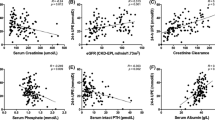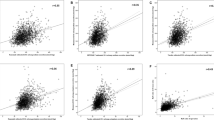Abstract
Urinary calcium/creatinine ratio (UCa/Cr) on a single spot urine sample is frequently used in children to evaluate calciuria, but its accuracy to estimate 24-h urinary calcium excretion (24hUCa) has not been properly assessed. We analyzed the correlation between UCa/Cr in various spot samples and 24hUCa among healthy children. A 24-h urine specimen and three spot urine samples (evening, first, and second morning) were collected in a convenience sample of children aged 6 to 16 years (n = 101). Measured 24hUCa was compared with UCa/Cr in each of the three spot samples. The ability of UCa/Cr to discriminate between children with and without hypercalciuria (calciuria > 4 mg/kg/24 h, 1 mmol/kg/24 h) and optimal timing of the spot sample were determined. Eighty-five children completed an adequate 24-h urine collection. Pearson correlation coefficients between the UCa/Cr on the spot sample and 24hUCa were 0.64, 0.71, and 0.52 for the evening, first, and second morning spot samples, respectively. Areas under the ROC curve were 0.90, 0.82, and 0.75, respectively, for the corresponding spot samples.
Conclusion: The relatively strong correlation between 24hUCa and UCa/Cr in evening and first morning spot urine samples suggests that these spots could be preferred in clinical practice.
Trial registration: ClinicalTrials.gov, NCT02900261, date of trial registration 14 September 2016.
What is Known: •Urinary calcium/creatinine ratio on a single spot urine sample is frequently used as a proxy for 24-h urinary calcium excretion. •Correlation of these indicators, including the best timing for spot urine sampling, has not been properly assessed. | |
What is New: •Relatively strong correlations were found between the calcium/creatinine ratio on a single spot urine sample and 24-h urinary calcium excretion in healthy children. •Evening and first morning spot samples had the highest correlation. |



Similar content being viewed by others
Abbreviations
- UCa/Cr:
-
Urinary calcium/creatinine ratio
- 24hUCa:
-
24-h Urinary calcium excretion
- NPV:
-
Negative predictive value/s
- PPV:
-
Positive predictive value/s
References
Coward RJM, Peters CJ, Duffy PG, Corry D, Kellett MJ, Choong S, van't Hoff W (2003) Epidemiology of paediatric renal stone disease in the UK. Arch Dis Child 88:962–965. https://doi.org/10.1136/adc.88.11.962
Dwyer ME, Krambeck AE, Bergstralh EJ, Milliner DS, Lieske JC, Rule AD (2012) Temporal trends in incidence of kidney stones among children: a 25-year population based study. J Urol 188:247–252. https://doi.org/10.1016/j.juro.2012.03.021
Issler N, Dufek S, Kleta R, Bockenhauer D, Smeulders N, van‘t Hoff W (2017) Epidemiology of paediatric renal stone disease: a 22-year single centre experience in the UK. BMC Nephrol 18:136. https://doi.org/10.1186/s12882-017-0505-x
Langman CB, Moore ES (1984) Hypercalciuria in clinical pediatrics. Rev Clin Pediatr (Phila) 23:135–137. https://doi.org/10.1177/000992288402300301
Vijayakumar M, Nageswaran P, Tirukalathi OM et al (2014) Descriptive study of clinical profile and benefit of therapy in childhood hypercalciuria. Int J Nephrol Renov Dis 7:69–73. https://doi.org/10.2147/IJNRD.S53541
Kliegman R, Behrman RE, Nelson WE (2016) Nelson textbook of pediatrics, edition 20. Elsevier, Phialdelphia, PA
Butani L, Kalia A (2004) Idiopathic hypercalciuria in children--how valid are the existing diagnostic criteria? Pediatr Nephrol Berl Ger 19:577–582. https://doi.org/10.1007/s00467-004-1470-8
Chan KH, Moser EA, Whittam BM et al (2019) Initial collection of an inadequate 24-hour urine sample in children does not predict subsequent inadequate collections. J Pediatr Urol 15:74.e1–74.e7. https://doi.org/10.1016/j.jpurol.2018.10.019
Ghazali S, Barratt TM (1974) Urinary excretion of calcium and magnesium in children. Arch Dis Child 49:97–101. https://doi.org/10.1136/adc.49.2.97
Koyun M, Güven AG, Filiz S, Akman S, Akbas H, Baysal YE, Dedeoglu N (2007) Screening for hypercalciuria in schoolchildren: what should be the criteria for diagnosis? Pediatr Nephrol Berl Ger 22:1297–1301. https://doi.org/10.1007/s00467-007-0528-9
Choi IS, Jung ES, Choi YE, Cho YK, Yang EM, Kim CJ (2013) Random urinary calcium/creatinine ratio for screening hypercalciuria in children with hematuria. Ann Lab Med 33:401–405. https://doi.org/10.3343/alm.2013.33.6.401
Rios-Leyvraz M, Bovet P, Tabin R, Genin B, Russo M, Rossier MF, Bochud M, Chiolero A (2018) Urine spot samples can be used to estimate 24-hour urinary sodium excretion in children. J Nutr 148:1946–1953. https://doi.org/10.1093/jn/nxy211
Rios-Leyvraz M, Bovet P, Bochud M, Genin B, Russo M, Rossier MF, Tabin R, Chiolero A (2018) Estimation of salt intake and excretion in children in one region of Switzerland: a cross-sectional study. Eur J Nutr 58:2921–2928. https://doi.org/10.1007/s00394-018-1845-4
Remer T, Neubert A, Maser-Gluth C (2002) Anthropometry-based reference values for 24-h urinary creatinine excretion during growth and their use in endocrine and nutritional research. Am J Clin Nutr 75:561–569. https://doi.org/10.1093/ajcn/75.3.561
Matos V, van Melle G, Boulat O, Markert M, Bachmann C, Guignard JP (1997) Urinary phosphate/creatinine, calcium/creatinine, and magnesium/creatinine ratios in a healthy pediatric population. J Pediatr 131:252–257. https://doi.org/10.1016/s0022-3476(97)70162-8
Sargent JD, Stukel TA, Kresel J, Klein RZ (1993) Normal values for random urinary calcium to creatinine ratios in infancy. J Pediatr 123:393–397. https://doi.org/10.1016/s0022-3476(05)81738-x
Reusz GS, Dobos M, Byrd D et al (1995) Urinary calcium and oxalate excretion in children. Pediatr Nephrol Berl Ger 9:39–44
Kuczmarski RJ, Ogden CL, Guo SS et al (2002) 2000 CDC Growth charts for the United States: methods and development. Vital Health Stat 11:1–190
Cook NR (2007) Use and misuse of the receiver operating characteristic curve in risk prediction. Circulation 115:928–935. https://doi.org/10.1161/CIRCULATIONAHA.106.672402
De Santo NG, Di Iorio B, Capasso G et al (1992) Population based data on urinary excretion of calcium, magnesium, oxalate, phosphate and uric acid in children from Cimitile (southern Italy). Pediatr Nephrol Berl Ger 6:149–157
Alconcher LF, Castro C, Quintana D, Abt N, Moran L, Gonzalez L, Cella M, Torelli M (1997) Urinary calcium excretion in healthy school children. Pediatr Nephrol Berl Ger 11:186–188
Acknowledgments
We thank Rosemary Sudan for her help in reviewing the manuscript.
Informed consent
Written consent was obtained from one of the parents (or legal guardian) and the oral consent of the child. In addition, written consent of the child was obtained for those over 14 years.
Funding
This study was supported by Swiss Federal Food Safety and Veterinary Office (FSVO) grant 5.15.03. The funder had no role in the protocol development, data collection, data analysis, or interpretation or publication of the results.
Author information
Authors and Affiliations
Contributions
Mr. Paccaud contributed to design the study, interpreted analyses, and drafted the initial manuscript; Dr. Rios-Leyvraz contributed to design the study, recruited participants, managed data, performed statistical analyses, and critically reviewed the manuscript; Pr Chiolero conceptualized and designed the study, obtained funding, supervised statistical analyses, and critically reviewed the manuscript; Pr Parvex contributed to design the study and to interpret analyses, and critically reviewed the manuscript; Dr. Rossier conducted laboratory analyses and critically reviewed the manuscript; Pr Bochud and Pr Bovet contributed to study design and to interpreted analyses, and critically reviewed the manuscript; Pr Tabin contributed to the study design, recruited participants for the study, and critically reviewed the manuscript; Pr Genin and Dr. Russo recruited participants for the study and critically reviewed the manuscript. All authors approved the final manuscript as submitted and agree to be accountable for all aspects of the work.
Corresponding author
Ethics declarations
Conflict of interest
The authors declare that they have no conflicts of interest.
Ethical approval
The study was approved by the ethics research committee of the canton of Vaud (CER-VD, identification number: 2015-01178).
Additional information
Communicated by Gregorio Paolo Milan
Publisher’s note
Springer Nature remains neutral with regard to jurisdictional claims in published maps and institutional affiliations.
Electronic supplementary material
ESM 1
Scatterplots for calcium excretion in 24-h urine measured and spot urine samples estimated with Ghazali equation. Black continuous line: identity line, i.e., perfect correlation; blue line: linear regression; red lines: calcium excretion > 4 mg/kg/24 h (> 1 mmol/kg/24 h) is considered high (PNG 855 kb)
Rights and permissions
About this article
Cite this article
Paccaud, Y., Rios-Leyvraz, M., Bochud, M. et al. Spot urine samples to estimate 24-hour urinary calcium excretion in school-age children. Eur J Pediatr 179, 1673–1681 (2020). https://doi.org/10.1007/s00431-020-03662-z
Received:
Revised:
Accepted:
Published:
Issue Date:
DOI: https://doi.org/10.1007/s00431-020-03662-z




